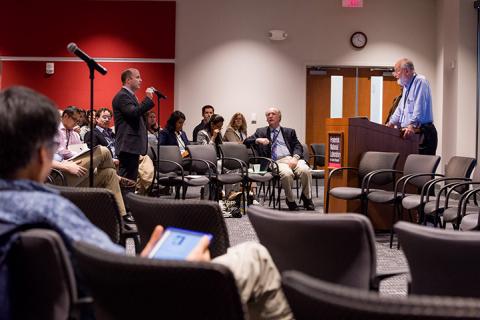
Stephan Stern, Ph.D., Nanotechnology Characterization Laboratory, asks Joost Oppenheim, M.D., Cancer and Inflammation Program, National Cancer Institute, a question at the 2017 Technology Showcase.
Before a crowded auditorium of science and business professionals at the Frederick National Laboratory for Cancer Research’s (FNLCR) Advanced Technology Research Facility (ATRF), Joost Oppenheim, M.D., had just finished his presentation about a compound with the potential to expand the impact of a promising category of cancer therapeutics when he fielded a question from Stephan Stern, Ph.D.
Stern, senior principal scientist in the Nanotechnology Characterization Laboratory (NCL), FNLCR, asked if Oppenheim, senior investigator in the National Cancer Institute’s (NCI) Cancer and Inflammation Program, had looked into advanced technology to measure pharmacokinetics—the movement of drugs within the body—to expand his research. Oppenheim explained that he hadn’t due to the expense, but Stern mentioned that the NCL offers that resource “just outside these doors” at the ATRF.
“Let’s talk after,” said Oppenheim.
The interaction was one of the central goals of the inaugural 2017 Technology Showcase, held at the ATRF on June 7. The event featured technologies being developed at the FNLCR and the NCI to encourage startup company formation, technology licensing, and collaborations.
More than 200 science and business professionals from across the region attended the event. Sponsors included NCI’s Technology Transfer Center, the FNLCR, the Frederick County and City Offices of Economic Development, the Maryland Technology Development Corporation, the Technology Council of Maryland, and the Frederick Innovative Technology Center, Inc.
Frederick County is home to more than 80 biotechnology companies. During the showcase event, city and county officials highlighted the region’s distinct collaborative opportunities, innovative partnerships, and groundbreaking research.
“The county is a hub for innovation, and innovation drives business,” explained Frederick County Executive Jan Gardner during her remarks at the event. “We believe tech transfer will strengthen our economic base.”
The FNLCR was well-represented at the showcase with three presentations that explored cutting-edge technology and its applications to cancer research. All of these technologies are available for licensing.
Steven Adler, Ph.D., Clinical Monitoring Research Program, FNLCR, is an expert in clinical imaging techniques for cancer and examines ways to better evaluate imaging data for cancer assessment. He explained how his Java-based, general purpose computer software can automate analysis capabilities in positron emission tomography (PET) scanners, which are used to image tissue activity based in metabolic profiles. This would make analysis of such images faster and more accurate.
Dominic Esposito, Ph.D., RAS Initiative, Cancer Research Technology Program, FNLCR, introduced three technologies that could significantly improve current methods to develop high-quality and high-throughput protein-based cancer therapeutic candidates by taking advantage of insect cell machinery. His presentation included new molecular biology tools for more easily making baculovirus (a family of viruses that is pathogenic for insects and is a powerful tool for producing proteins in the lab), a modified insect cell line to produce a faster and more accurate reading of proteins when infected with baculovirus, and a new cell line for better production of proteins and potential systems biology applications.
Stern talked about his work to design and implement pharmacology and toxicology studies used to characterize nanomedicines and their biocompatibility. Because it is such a new technology, the characterization of nanomedicines is challenging but fundamental to understanding their therapeutic advantage. Stern developed a method to evaluate the fractions of drugs within and released from nanomedicines by using cutting-edge technology to minimize technical complications. His work allows for improved nanomedicine characterization, which can help inform regulatory agencies like the Food and Drug Administration that are interested in novel nanomedicine drug release methods for the bioequivalence testing of generic drugs.
Many NCI investigators also shared their technology research, including developing vaccines against human polyomaviruses, the ability to produce custom antibodies, and ratio-based biomarkers for cancer survival prediction.
“This was a great opportunity to bring together those invested in commercializing technologies to help battle cancer,” said Jim Pannucci, Ph.D., FNLCR Partnership Development Office director. “With attendees from pharmaceutical companies, smaller local startups, DoD government laboratories, and various private and nonprofit organizations that exist to support small businesses, the mix encouraged discussions that will lead to new partnerships to advance cancer therapeutics. We look forward to seeing these evolve.”
Plans are already underway for next year’s event, which will be held June 13, 2018.

